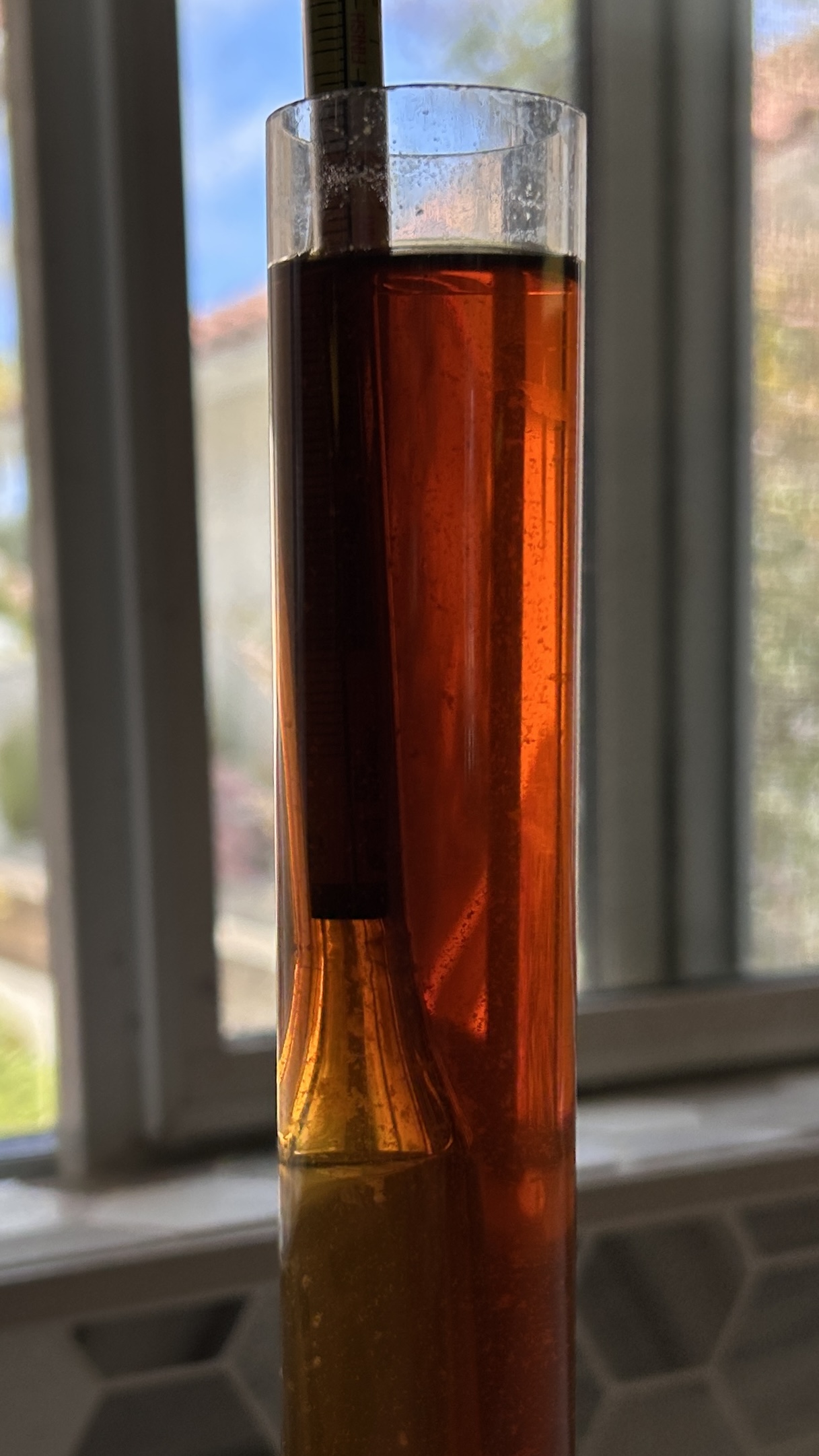- Recipe Type
- All Grain
- Yeast
- Saflager W-34/70
- Yeast Starter
- N/A
- Batch Size (Gallons)
- 3.4
- Original Gravity
- 1.053
- Final Gravity
- 1.014
- Boiling Time (Minutes)
- 60
- IBU
- 25.4
- Color
- 15.5 SRM
- Primary Fermentation (# of Days & Temp)
- 14-21 days @ 54 °F
- Tasting Notes
- A smooth, malty version of Dunkel
Here is my version of a Munich Dunkel lager. I researched the style and this is comparable to some commercial versions I've had.
NOTE: THIS IS A 3.4 GALLON BATCH SIZE WITH A FINAL KEGGING VOLUME OF 3 GALLONS!!!
I BIAB so you may need to adjust the grain bill to match your rig as well as scale up or down depending on your needs.
Being a 3 gallon recipe, 1 package of 34/70 was sufficient for this size.
Dunk!!!
Munich Dunkel
Type: All Grain Date: 28 Jul 2019
Batch Size (fermenter): 3.40 gal
Brewer: Nick
Boil Size: 4.77 gal
Boil Time: 60 min
Equipment: Windblown Brewery 3 gal
End of Boil Volume 3.67 gal
Brewhouse Efficiency: 74.00 %
Final Bottling Volume: 3.00 gal
Measured Mash Efficiency 80.4 %
Fermentation: 14-21 days @ 54° Single stage
Taste Rating(out of 50): 42.0
Ingredients
Amt Name Type # %/IBU
5 lbs 4.0 oz Munich Malt (9.0 SRM) Grain 1 77.0 %
1 lbs 4.0 oz Pilsner (2 Row) Ger (2.0 SRM) Grain 2 18.3 %
2.5 oz Carafa I (337.0 SRM) Grain 3 2.3 %
2.5 oz Melanoidin Malt (27.0 SRM) Grain 4 2.3 %
1.00 oz Tettnanger [3.70 %] - Boil 60.0 min Hop 16.2 IBUs
0.50 oz Tettnanger [3.70 %] - Boil 30.0 min Hop 6.2 IBUs
0.50 oz Tettnanger [3.70 %] - Boil 10.0 min Hop 2.9 IBUs
0.5 Whirlfloc Tablet (Boil 5.0 mins) Fining
1.0 pkg Saflager Lager (DCL/Fermentis W-34/70) Yeast
Beer Profile
Est Original Gravity: 1.053 SG Measured Original Gravity: 1.053 SG
Est Final Gravity: 1.013 SG Measured Final Gravity: 1.014 SG
Estimated Alcohol by Vol: 5.3 % Actual Alcohol by Vol: 5.2 %
Bitterness: 25.4 IBUs Calories: 177.4 kcal/12oz
Est Color: 15.5 SRM
Mash Profile
Mash Name: BIAB, Medium Body
Total Grain Weight: 6 lbs 13.0 oz
Sparge Water: 0.00 gal
Grain Temperature: 72.0 F
Sparge Temperature:
Tun Temperature: 72.0 F
Adjust Temp for Equipment: TRUE Estimated Mash PH: 5.5
Mash Steps
Name Description Step Temperature Step Time
Saccharification Add 5.11 gal of water at 158.9 F Mash @ 153.0 F 60 min
Sparge Step: If steeping, remove grains, and prepare to boil wort
Mash Notes: Brew in a bag method where the full boil volume is mashed within the boil vessel and then the grains are withdrawn at the end of the mash. No active sparging is required. This is a medium body beer profile.
Carbonation and Storage
Carbonation Type: Keg Volumes of CO2: 2.5
Pressure/Weight: 14.89 PSI Carbonation Used: Keg with 14.89 PSI
Keg/Bottling Temperature: 36.0 F Age for: 30.00 days


NOTE: THIS IS A 3.4 GALLON BATCH SIZE WITH A FINAL KEGGING VOLUME OF 3 GALLONS!!!
I BIAB so you may need to adjust the grain bill to match your rig as well as scale up or down depending on your needs.
Being a 3 gallon recipe, 1 package of 34/70 was sufficient for this size.
Dunk!!!
Munich Dunkel
Type: All Grain Date: 28 Jul 2019
Batch Size (fermenter): 3.40 gal
Brewer: Nick
Boil Size: 4.77 gal
Boil Time: 60 min
Equipment: Windblown Brewery 3 gal
End of Boil Volume 3.67 gal
Brewhouse Efficiency: 74.00 %
Final Bottling Volume: 3.00 gal
Measured Mash Efficiency 80.4 %
Fermentation: 14-21 days @ 54° Single stage
Taste Rating(out of 50): 42.0
Ingredients
Amt Name Type # %/IBU
5 lbs 4.0 oz Munich Malt (9.0 SRM) Grain 1 77.0 %
1 lbs 4.0 oz Pilsner (2 Row) Ger (2.0 SRM) Grain 2 18.3 %
2.5 oz Carafa I (337.0 SRM) Grain 3 2.3 %
2.5 oz Melanoidin Malt (27.0 SRM) Grain 4 2.3 %
1.00 oz Tettnanger [3.70 %] - Boil 60.0 min Hop 16.2 IBUs
0.50 oz Tettnanger [3.70 %] - Boil 30.0 min Hop 6.2 IBUs
0.50 oz Tettnanger [3.70 %] - Boil 10.0 min Hop 2.9 IBUs
0.5 Whirlfloc Tablet (Boil 5.0 mins) Fining
1.0 pkg Saflager Lager (DCL/Fermentis W-34/70) Yeast
Beer Profile
Est Original Gravity: 1.053 SG Measured Original Gravity: 1.053 SG
Est Final Gravity: 1.013 SG Measured Final Gravity: 1.014 SG
Estimated Alcohol by Vol: 5.3 % Actual Alcohol by Vol: 5.2 %
Bitterness: 25.4 IBUs Calories: 177.4 kcal/12oz
Est Color: 15.5 SRM
Mash Profile
Mash Name: BIAB, Medium Body
Total Grain Weight: 6 lbs 13.0 oz
Sparge Water: 0.00 gal
Grain Temperature: 72.0 F
Sparge Temperature:
Tun Temperature: 72.0 F
Adjust Temp for Equipment: TRUE Estimated Mash PH: 5.5
Mash Steps
Name Description Step Temperature Step Time
Saccharification Add 5.11 gal of water at 158.9 F Mash @ 153.0 F 60 min
Sparge Step: If steeping, remove grains, and prepare to boil wort
Mash Notes: Brew in a bag method where the full boil volume is mashed within the boil vessel and then the grains are withdrawn at the end of the mash. No active sparging is required. This is a medium body beer profile.
Carbonation and Storage
Carbonation Type: Keg Volumes of CO2: 2.5
Pressure/Weight: 14.89 PSI Carbonation Used: Keg with 14.89 PSI
Keg/Bottling Temperature: 36.0 F Age for: 30.00 days


Last edited by a moderator:





















![Craft A Brew - Safale S-04 Dry Yeast - Fermentis - English Ale Dry Yeast - For English and American Ales and Hard Apple Ciders - Ingredients for Home Brewing - Beer Making Supplies - [1 Pack]](https://m.media-amazon.com/images/I/41fVGNh6JfL._SL500_.jpg)






































